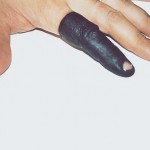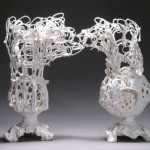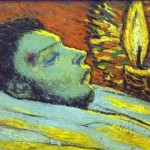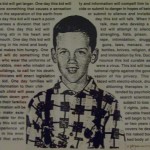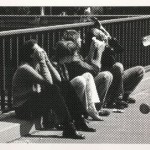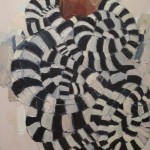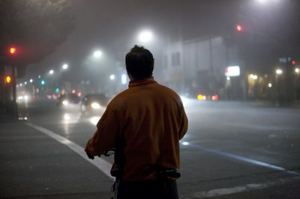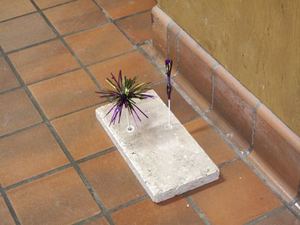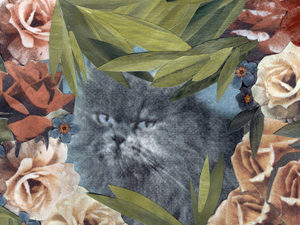Silke Zeidler (Click to enlarge.)
Main Content
The Icarus question, continued
Brianna Sendziak, Sea, 40 x 30 inches, C-print, 2009
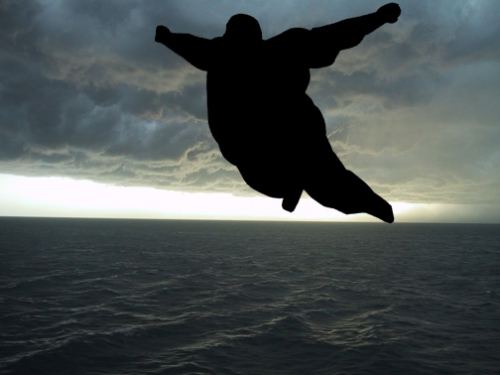 More Icarus here.
More Icarus here.
End days for Garden and Cosmos
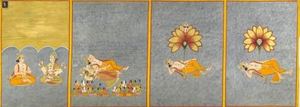 Garden and Cosmos: The Royal paintings of Jodhpur closes on Sunday at the Seattle Asian Art Museum. More information than you want to read here.
Garden and Cosmos: The Royal paintings of Jodhpur closes on Sunday at the Seattle Asian Art Museum. More information than you want to read here.
A lot younger than Jesus at the Jacob Lawrence Gallery
In response to Jen Graves’ provocative article, The Vancouver Problem (my response here), Ries Niemi logged the following reflections on Artdish, quoted in part:
I know a lot of Vancouver artists- and, some of them are just like Jen
describes, while others are just as provincial as she accuses Seattle
artists of being.
And in Vancouver, the shadow of a certain style of text and photo
based, detached and cold conceptual work, somewhat Baldessari-esqe,
hangs over a lot of the artists.
There has been a big concern lately, as Emily Carr has been closing all
the “crafty” art departments, and going more and more towards a Photoshop-only curriculum, that nothing but one style of art is
“approved” in Vancouver. And, strangely enough, THE EXACT SAME THING
has been happening at the (University of Washington).
Ries:
The text/photo crowd, most of whom are not “cold and detached” although
there’s nothing wrong with an ambitious chill, is in the ascendancy
everywhere. The extra reason why at the University of
Washington comes down to faculty: photographer Paul Berger and photo-technician/curator Michael Horn (neither of whom has a Web site), along with Rebecca Cummins and Ellen Garvens. Add the recently demised Larry Sommers, and you’ve got the Pied Pipers of the art department.
A
good crew graduates from the UW this year with BFAs in photography,
video and whatever trails those categories as installations.(Exhibit at
the Jacob Lawrence Gallery, through May 2. Tuesdays-Saturdays, noon-4)
From Sol Hashemi, Special Event
is a collage of the world’s corny surfaces, what takes up space around
us, our sometimes inadvertent lightening and brightening touches. At the
last minute, Hashemi added to the show a forlorn construct he’d made on
his way in, titled, Untitled (Mardi Gras Mylar Spray Pick #2).
He was doubtless thrilled to see it booted out soon after and placed
near a trash can, not in the trash can, which I presume would have been
better.
(Click images to enlarge.)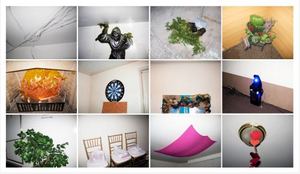 In the spirit of Robert Rauschenberg, rejoice.
In the spirit of Robert Rauschenberg, rejoice.
[Read more…] about A lot younger than Jesus at the Jacob Lawrence Gallery
Congratulations, Holland Cotter
Mr. Cotter won the Pulitzer for criticism, story here.
Art critics have long been passed over for Pultizers. He’s an excellent
place to start. In an Allan M. Jalon profile of Cotter last December in
the Columbia Journalism Review (only the lead online), Jalon quoted me
saying..:
Of all the critics out there, I think I might like Cotter the most, not
only for his knowledge and insight (lots of critics have that) but for
the heart and soul he quietly brings to each piece.
Frank Zoretich – the cat god
Frank Zoretich was leaving the PI as I arrived. We met in passing but kept up, at first through his newsletters sent under the title, Friends of Frank, and later, as his fame grew, in a second edition, Friends of Friends of Frank. At the PI, he was known as the king of fluff, a title he wore with pride. Let others battle for the big news story, the trend, the deepish investigative foray. Zoretich is all about what others with an eye on the substantial disdain, such as, stories about cats.
Back in Seattle after stints at several newspapers in the Southwest, Frank contributed My God, the Cat! to A News Cafe, his first online only venture.
(Image, Julia Salamonik. Click to enlarge)
The problem with religion so far is that humans have chosen such
unreasonable gods to worship. Why haven’t we been smart enough to have
gods who are easy to please, who make demands we can meet without
excessive sacrifice?It’s a problem that vexed me for years – but I’ve solved it.
Although I always liked my cat, it wasn’t until I decided to embrace
theofelinity that our relationship deepened into something refreshingly
spiritual.A cat is a wonderful god. I’m not talking about the big cats like
lions or tigers or the fearsome part-feline beasts worshipped by
certain ancient civilizations. No, the perfect god is a house cat, a
god not likely to eat you alive for some minor infraction of its rules,
a god grudgingly dependent upon you for its survival, a god, in short,
very much like my cat.Scratch (that’s his name) requires only food on a regular basis, a
place to sleep that’s warm and dry, and petting sufficient to energize
his purr.Prayer to a cat is entirely optional. Despite the most fervent
pleading for divine favor, a cat will not intercede on your behalf. It
would be a waste of time to ask a cat to improve the weather, increase
the harvest, rescue you from financial difficulty, or smite your
enemies.And there is little to dread in the way of punishment for
transgressions, although Scratch did once afflict me with the
pestilence of ringworm. (Continued here)
You think you can draw? Portrait challenge at the Baby Seal Club
Ryan Molenkamp, artist and security chief at the Frye, reports that museum guards have more to fear than the agony of da feet. Boredom eats the soul. To combat this eating away, the artists on the Frye team organized a portrait challenge in 2004, open to all comers. In ever more ambitious forms, it continues. Writes Molenkamp:
Subjects were taken from the various discarded magazines floating around the museum. The challenge amounted to a small photo being pasted in a standard sheet of paper,
and 6 empty boxes placed below it…The results ranged from realistic renderings to insightful caricatures,
silly pictures to conceptual musings, and everything in between.
(Besides guards), participants over the years have ranged from artists Mark
Ryden, Jennifer Zwick and Cait Willis to folks
with no artistic training what-so-ever…This year’s highlight will be highlight an interactive section of 100 new, blank portrait
challenges which the public will be asked to fill up with the night of
the show.
Baby Seal Club, 619 Western Ave., third floor. May 7, 6-10 pm. Sample from the past below.
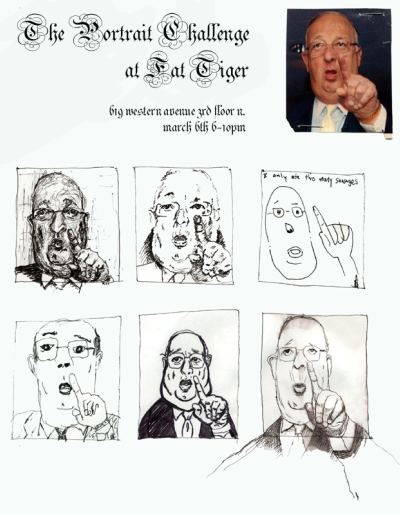
The 1980s – Like a rubber ball, they come bouncing back to you
Allan McCollum, Surrogate Paintings, 1979-1981

Jil Weinstock,
Green Frame Tableau,
pigmented cast rubber,
50″ x 90″ x 2″ 2008
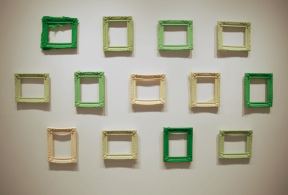
Ann Lislegaard – the clean edge of a remote space
The two poles of contemporary video art could be represented by South Africa’s William Kentridge (previous post) and Norway’s Ann Lislegaard. He’s the raw to her cooked, the coarse to her silky, the earth to her alien tread.
Since both have solo shows at the Henry (his upstairs, hers down), a little compare and contrast is inevitable, but each deserves to be seen in his/her own light.
Henry, take a bow. These shows make sense in relation to each other. The idea behind their presentation is clear – a survey from mountain top to mountain top. The third ingredient of good programming – an acknowledgment of where the Henry itself is located in the world – is missing, however. What are the NW video affinities?
At the very least, a small Gary Hill show would have been a fine thing. Seattle’s Hill stands between Kentridge and Lislegaard, leaning toward her. More accurately, she leans toward him. She matches his cool clear-sightedness, his intellectual rigor. Unlike hers, his work (like Kentridge’s) is rooted in body awareness and the tragedy of its struggles on the road to death.
Lislegaard shares Hill’s interest in language as a manifestation of
sculptural presence, but the meaning he derives is visceral, while hers
is as remote as the North Star.
(Gary Hill, still photo from Wall Piece, video. His insights along with a portion of the video here.)
Click images to enlarge.
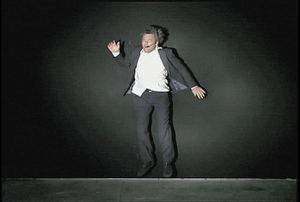 At the Henry, organized by senior curator Elizabeth Brown, are a trio of Lislegaard’s digital-animation installations inspired by science fiction. In her antiseptic world, life mutates without birth pangs from solids to liquids, spare interiors to false-front forests and texts that clarify before they blur and run.
At the Henry, organized by senior curator Elizabeth Brown, are a trio of Lislegaard’s digital-animation installations inspired by science fiction. In her antiseptic world, life mutates without birth pangs from solids to liquids, spare interiors to false-front forests and texts that clarify before they blur and run.
(Lislegaard, from Crystal World (after J.G. Ballard)
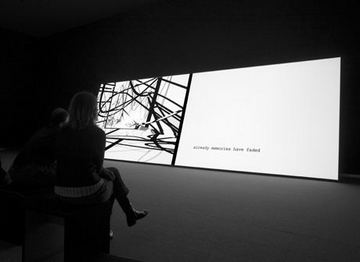 The chill from her work is real, and so is its power. Black cut against white softens to gray and turns into water. Her view of physics argues against the idea of personal volition.
The chill from her work is real, and so is its power. Black cut against white softens to gray and turns into water. Her view of physics argues against the idea of personal volition.
Lislegaard, Bellona (after Samuel R. Delany)
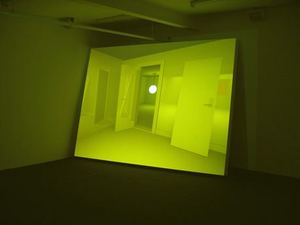 It’s a theory of everything that leaves everything out. In her
It’s a theory of everything that leaves everything out. In her
gravitational flow, we are dead stars visible on time borrowed from the
past. She’s interested in the world without the world, what impressions it leaves on the flexible coils of matter.
Note: I was thrilled to see two small exhibits honoring NW artists who died this year, Richard C. Elliott (my obit here) and Doris Totten Chase (my obit here). From no other art museum is there any indication that they lived and died here, and both mattered greatly. Bloom where you’re planted, people. You are not curating on Mars. (Thank you, Henry Gallery associate curator Sara Krajewski.)
William Kentridge – Life in Plato’s Cave
Behold!
human beings living in an underground cave, which has a mouth open towards the light and reaching all
along the cave; here they have been from their childhood, and have their legs and necks chained so that
they cannot move, and can only see before them, being prevented by the chains from turning round their
heads. Above and behind them a fire is blazing at a distance, and between the fire and the prisoners there
is a raised way; and you will see, if you look, a low wall built along the way, like the screen which
marionette players have in front of them, over which they show the puppets. – Plato, Book Seven of the Republic, from Allegory of the Cave.
Plato waited a long time for an artist who could scratch on his wall and give his metaphor visual life. (Click images to enlarge.)
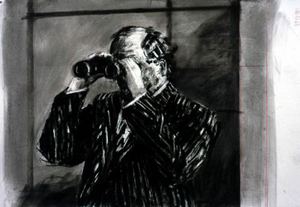 Kentridge isn’t interested in following Plato to the end of the line, aspiring to the idea of Divine Form. Leaving that hopeless ideal to minimalists, he stays in the cave with writers like Henry Miller, who wrote that “chaos is the score on which reality is written.”
Kentridge isn’t interested in following Plato to the end of the line, aspiring to the idea of Divine Form. Leaving that hopeless ideal to minimalists, he stays in the cave with writers like Henry Miller, who wrote that “chaos is the score on which reality is written.”
In the chaos of the cave, Kentridge picks up what could be a stick blackened in a fire and draws in a coarse hand. His films are one-step up from flip books. In his deft, rude style, the hard gravel of who we are finds its advocate.
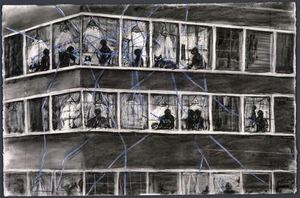 Kentridge continues at the Henry Gallery through May 3, with three videos, suites of drawings and tar-like sculptures.
Kentridge continues at the Henry Gallery through May 3, with three videos, suites of drawings and tar-like sculptures.



